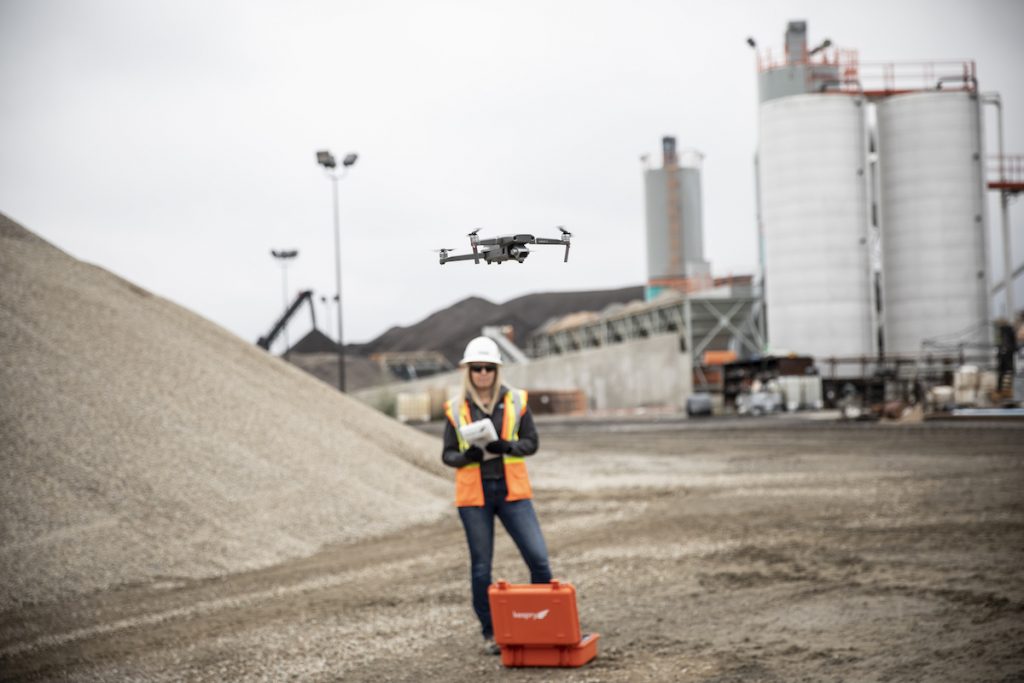
Features
Aggregates
Pits & Quarries
Aerial Intelligence and how it serves the aggregate industry
December 18, 2020 By Jay Koblun
 “Aerial Intelligence (AI) uses drones to collect, process and analyze data at pits and quarries. Image: Kespry
“Aerial Intelligence (AI) uses drones to collect, process and analyze data at pits and quarries. Image: Kespry Kespry recently shared its Winter 2020 Aerial Intelligence platform updates aimed at helping businesses across the mining and aggregate industries launch visual intelligence programs.
“Aerial Intelligence (AI) uses drones to collect, process and analyze data at sites. It can help measure stockpile volumes and manage inventory across multiple sites accurately,” says Krishnan Hariharan, Kespry’s general manager and vice-president of engineering.
Hariharan says when he uses the word drone, people tend to think of a quadcopter or quadrotor, a type of helicopter with four rotors, but AI is much broader than that.
“Think about this, when you talk about drones, people think about quadcopters, the drone with four fans that goes up and down. Drones can also be fix wing, look like an airplane, takeoff vertically. Some drones you can even more or less throw like a paper airplane and watch it take off. A lot of industries define drones as more than a quadcopter, so that’s what Aerial Intelligence is – the ability to fly drones automatically or with minimal human effort.”
Hariharan said AI is used to provide survey grade accuracy that Kespry uses to calculate quantities, or update mine plans, digital surface models, or topography changes at a site that are captured in multiple flights over a series of time. He added that one of the biggest benefits AI is to the aggregate and ministry industry is that they can eliminate the need for Ground Control Points (GCP).
“When you are flying a drone in the air, it needs certain reference points to complete its flight plan. So, when you look at a complicated drone flight plan, people place GCPs around a site for the drone to use as reference to fly.
“We eliminate the need to put GCPs specifically in mining and aggregates where it’s very hard to find the right place to put GCPs. That’s how we define AI and the benefits that we provide mining and aggregates.”
Hariharan says the software can be broken down into three main steps:
Step One: Plan and Fly – Once the drone is launched by tapping the “take-off” button, the drone flies the mission plan autonomously, then returns to the take-off area for landing.
Step Two: Automated Analysis – Once the drone data has been captured, it is uploaded to the cloud. For aggregates, mining, and construction, 2D and 3D models of the entire site ready for analysis are generated.
Step Three: Business Insights – A complete model of a site is available for users to accurately determine distances, elevations, and volumes. Aggregates, mining, and construction users can generate stockpile volumes, cut/fill analysis, and detailed topography across an entire site.
With respect to the Winter 2020 Aerial Intelligence platform update, Kespry is extending its “Bring Your Own Drone” program.
“A site manager can come to use and say ‘Listen we have our own fixed wing drones, we don’t need your flight management application. Can you integrate with our drones as a planning and management solution, but we want it to work with the drones we have?” and that’s something new we introduced recently that this year we are expanding on,” says Hariharan.
Kespry now offers support for WingtraOne. Clients can integrate with the Kespry platform and are able to process, store, and analyze WingtraOne RX1 PPK data on Kespry’s mapping platform. This enables the possibility to work with both Wingtra data and data captured with the company’s field-to-finish solution all in the same ecosystem. Kespry’s platform supports the latest hardware advancements, and Wingtra is a solution for mining and aggregate sites which span large areas and require high data accuracy.
“We’re looking forward to continuing this momentum into next year and delivering additional enhancements and tools,” said George Mathew, CEO and Chairman, Kespry.
Print this page